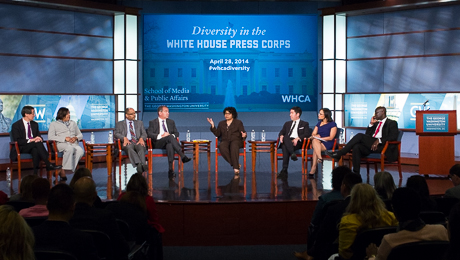Alice Dunnigan shattered barriers in 1948 when she became the first black female White House correspondent and the first black journalist to accompany a president on a campaign trail. Just four years earlier, her colleague Harry McAlpin had been fighting to cover White House press conferences while working for the National Negro Press Association. Again and again, his efforts were deterred—until a historic day in 1944, when President Roosevelt finally granted him credentials and made him the first African American reporter to attend a White House press conference.
Although the two journalists will always be regarded as trailblazers, neither of them wanted to be “firsts,” George Condon of the National Journal told an audience at the Jack Morton Auditorium on Monday. They wanted to be reporters who gave voice to questions important to their communities, marking the significance of a diverse press corps in the political arena.
This year, the White House Correspondents' Association (WHCA) celebrates its centennial and its history, which has over the years become more inclusive of many race and genders. However, there is more work to be done: Following Mr. Condon’s remarks, a panel discussion organized by the George Washington University School of Media and Public Affairs and the WHCA explored how critical it is to continue diversifying the press today.
The panelists included Jim Avila, senior national correspondent for ABC News and White House correspondent for ABC News and Fusion; Ed Chen, director of communications at the National Resources Defense Council, former
president of the WHCA and former White House correspondent for the LA Times and Bloomberg; Kevin Merida, managing editor for the Washington Post; David Nakamura, White House reporter for the Washington Post; Sonya Ross, race and ethnicity editor for the Associated Press; Ken Strickland, Washington bureau chief for NBC News; and Kristen Welker, White House reporter for NBC News. April Ryan, White House reporter for American Urban Radio Networks, moderated the conversation.
During a trip to New Orleans on the anniversary of Hurricane Katina, then-President George W. Bush had a conversation with Ms. Ryan that she still thinks about today. He told her he didn’t think the briefing room boasted a representation of America and that there needed to be more minorities in there.
“Sometimes, I walk through that room and I glance around as the press conferences or briefings are getting ready to happen, and I don’t see a representation of America,” Ms. Ryan said.
Ms. Welker is often hit with a similar reality. She frequently finds that she’s the only female journalist of color in the briefing room.
“I feel the weight of that responsibility… It’s important that the group of people there is representative of the diversity we see in the country. As reporters, we bear the background of our experiences,” she said.
Personal experience engenders new perspectives, which makes a diverse press corps crucial. Managers of newspapers and other media organizations have to draw out talent from people of myriad ethnic backgrounds, Mr. Strickland said, because many issues covered in Washington affect diverse populations.
“You need people who have had that personal experience—people who have had relatives who have been on Medicare or Medicaid, people who are dealing with immigration issues—to really look at those issues versus the shiny objects we all get whipped up about that are on the front pages of papers,” Mr. Strickland said.
The panelists advised students interested in journalism to go out and use their experiences to nab stories no one else is covering. As a reporter at the Dallas Morning News, Mr. Merida would sometimes get invitations to go running with then-President George W. Bush. Rather than shy away, Mr. Merida began leaving an extra pair of sneakers in the office and using the runs to talk to the president about topics others weren’t asking him about, including books, movies and his love for Texas.
Establishing personal connections, Mr. Chen added, is also “a tremendous key to opening a person’s mind and heart, and giving you special insight into that person. In this town, I’ve found that works very, very well.”
When one Elliott School junior asked about paid internships for minority students, Ms. Ross pointed him to the AP’s global news internship program. She emphasized to students that opportunities for minorities to play a role in the press corps exist—it’s just a matter of aggressively fighting to earn experiences.
Mr. Strickland covered Capitol Hill for eight years while Barack Obama was a senator, and made it a point to make a connection with the future president.
“If you have a connection with something in this city and you don’t use it to your advantage, you’re not being smart,” he told students. “Whatever tools the good lord gave you, use them. Ultimately, it comes down to what are you reporting, is it fair, is it accurate and does it have context? The facts trump all. Good storytelling trumps all,” he said.


